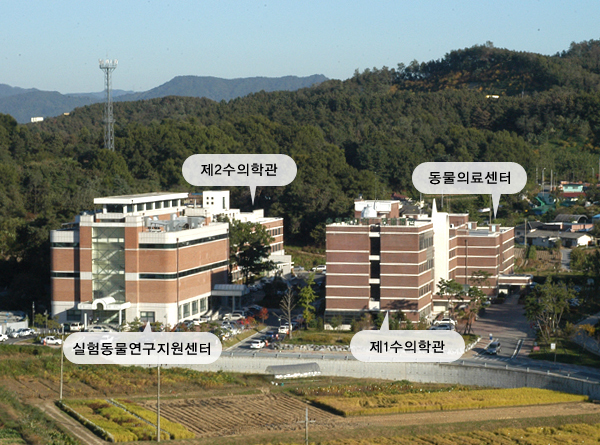Difference between revisions of "Korea - Chungbuk National University College of Veterinary Medicine"
m (Created page with "==Images== File:ChungbukNU 01.jpg<BR> <br>File:ChungbukNU_02.jpg ==Introduction== <!----Write below this line---> <BR> To advance animal and human health through ...") |
|||
| (One intermediate revision by one other user not shown) | |||
| Line 5: | Line 5: | ||
==Introduction== <!----Write below this line---> | ==Introduction== <!----Write below this line---> | ||
| − | + | ||
| + | <BR> To advance animal and human health through education, research, and public service, | ||
| + | <BR>Veterinary education at Chungbuk National University was organized as the Department of | ||
| + | <BR>Veterinary Medicine, College of Agriculture in March, 1989. The department was re-estab- | ||
| + | <BR>lished as the College of Veterinary Medicine in 1993. Six-year education system of under- | ||
| + | <BR>graduate course which was very innovative in Korean veterinary education was introduced in | ||
| + | <BR>1998. Now, we have Veterinary Medical Center where produce well-trained veterinarians and | ||
| + | <BR>service advanced diagnosis and treatment. Laboratory Animal Research Center and Research | ||
| + | <BR>Institute of Veterinary Medicine were opened for supply of laboratory animals and biomedi- | ||
| + | <BR>cal research. <BR><BR> | ||
==History== <!----Write below this line---> | ==History== <!----Write below this line---> | ||
| − | + | <BR> | |
| − | + | <BR>1989.03 Established as Major in Veterinary Medicine, College of Agricultural Science | |
| − | + | <BR>1992.07 Established Master Degree course, Graduate school | |
| − | + | <BR>1993.09 Established College of Veterinary Medicine | |
| − | + | <BR>1995.10 Established Ph.D course, Graduate school | |
| − | + | <BR>1997.03 Established Major in Pre-Veterinary Medicine, College of Natural Science | |
| − | + | <BR>2000.03 Established Veterinary Hospital | |
| − | + | <BR>2004.04 Second building of College of Veterinary Medicine is completed | |
| − | + | <BR>2006.03 Opening of Laboratory Animal Research Center | |
| − | + | <BR>2009.07 Pre-Veterinary Medicine Major is transfered to College of Veterinary Medicine (prior College of Natural Science) | |
| − | + | <BR> | |
| + | <BR> | ||
==Education== <!----Write below this line---> | ==Education== <!----Write below this line---> | ||
| − | A veterinary college student in Korea must complete the two-year(80 credits) pre-vet course and the four-year(160 credits) undergraduate courses of veterinary medicine. As an undergraduate student, he/she needs to complete the following subjects step-by-step: | + | <BR>A veterinary college student in Korea must complete the two-year(80 credits) pre-vet course and the four-year(160 credits) undergraduate courses |
| − | + | <BR>of veterinary medicine. As an undergraduate student, he/she needs to complete the following subjects step-by-step: | |
| − | + | <BR> | |
| − | + | <BR>Basic veterinary medicine - veterinary anatomy(comparative and neuroanatomy), veterinary histology, veterinary embriology, | |
| − | + | <BR> veterinary biotechnology, veterinary physiology, veterinary immunology, veterinary biochemistry, etc. | |
| − | + | <BR>Preventive veterinary medicine - veterinary pathology, veterinary pharmacology, veterinary toxicology, public health science(food and environmental | |
| − | + | <BR> hygiene), veterinary microbiology(bacteriology, virology), laboratory animal medicine, veterinary infectious diseases, | |
| − | + | <BR> veterinary parasitology, etc. | |
| − | + | <BR>Clinical veterinary medicine - veterinary internal medicine, veterinary surgery, veterinary obstetrics, veterinary clinical pathology, veterinary | |
| − | + | <BR> diagnostic Imaging, diseases of fowls, aquatic animal diseases, zoo and wildlife animal disease, veterinary jurisprudence, etc. | |
| − | + | <BR> | |
| − | + | <BR>After completing the whole courses of study, you will be qualified to take the national veterinary board hosted by the Ministry of Agriculture and | |
| − | + | <BR>Forestry. Once you achieve the veterinary license, you will become a professional veterinarian in Korea.<BR><BR> | |
| − | |||
| − | |||
| − | |||
| − | |||
| − | |||
| − | |||
| − | |||
| − | |||
| − | |||
| − | |||
| − | |||
| − | |||
| − | |||
| − | |||
| − | |||
| − | < | ||
| − | After completing the whole courses of study, you will be qualified to take the national veterinary board hosted by the Ministry of Agriculture and Forestry. Once you achieve the veterinary license, you will become a professional veterinarian in Korea. | ||
==Research== <!----Write below this line---> | ==Research== <!----Write below this line---> | ||
| − | ==Clinical== <!----Write below this line---> | + | ==Clinical== <!----Write below this line---> |
| − | |||
| − | |||
| − | |||
| − | |||
==School name== <!----Write below this line---> | ==School name== <!----Write below this line---> | ||
| Line 75: | Line 64: | ||
==Number of Undergraduates== <!----Write below this line---> | ==Number of Undergraduates== <!----Write below this line---> | ||
| − | + | ||
==Number of Postgraduates== <!----Write below this line---> | ==Number of Postgraduates== <!----Write below this line---> | ||
Revision as of 12:40, 25 September 2011
Images
Introduction
To advance animal and human health through education, research, and public service,
Veterinary education at Chungbuk National University was organized as the Department of
Veterinary Medicine, College of Agriculture in March, 1989. The department was re-estab-
lished as the College of Veterinary Medicine in 1993. Six-year education system of under-
graduate course which was very innovative in Korean veterinary education was introduced in
1998. Now, we have Veterinary Medical Center where produce well-trained veterinarians and
service advanced diagnosis and treatment. Laboratory Animal Research Center and Research
Institute of Veterinary Medicine were opened for supply of laboratory animals and biomedi-
cal research.
History
1989.03 Established as Major in Veterinary Medicine, College of Agricultural Science
1992.07 Established Master Degree course, Graduate school
1993.09 Established College of Veterinary Medicine
1995.10 Established Ph.D course, Graduate school
1997.03 Established Major in Pre-Veterinary Medicine, College of Natural Science
2000.03 Established Veterinary Hospital
2004.04 Second building of College of Veterinary Medicine is completed
2006.03 Opening of Laboratory Animal Research Center
2009.07 Pre-Veterinary Medicine Major is transfered to College of Veterinary Medicine (prior College of Natural Science)
Education
A veterinary college student in Korea must complete the two-year(80 credits) pre-vet course and the four-year(160 credits) undergraduate courses
of veterinary medicine. As an undergraduate student, he/she needs to complete the following subjects step-by-step:
Basic veterinary medicine - veterinary anatomy(comparative and neuroanatomy), veterinary histology, veterinary embriology,
veterinary biotechnology, veterinary physiology, veterinary immunology, veterinary biochemistry, etc.
Preventive veterinary medicine - veterinary pathology, veterinary pharmacology, veterinary toxicology, public health science(food and environmental
hygiene), veterinary microbiology(bacteriology, virology), laboratory animal medicine, veterinary infectious diseases,
veterinary parasitology, etc.
Clinical veterinary medicine - veterinary internal medicine, veterinary surgery, veterinary obstetrics, veterinary clinical pathology, veterinary
diagnostic Imaging, diseases of fowls, aquatic animal diseases, zoo and wildlife animal disease, veterinary jurisprudence, etc.
After completing the whole courses of study, you will be qualified to take the national veterinary board hosted by the Ministry of Agriculture and
Forestry. Once you achieve the veterinary license, you will become a professional veterinarian in Korea.
Research
Clinical
School name
College of Veterinary Medicine Chungbuk National University
Established
Location
Principal's name
Total number of Students
about 40 in each class, 240 in total
Number of Undergraduates
Number of Postgraduates
Website address
Contact details
410 SungBong-Ro Heungdeok-gu, Cheongju-si Chungbuk (361-763 Korea)
Tel:+82-43-261-2595


